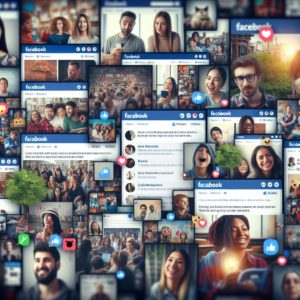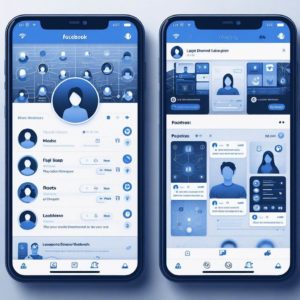
Watch video 2 -How Is A Facebook Group Different Than A Page
Recommended for you:
12+ Best Active Facebook Groups for Couples (Evergreen)
10+ Best Dating Groups On Facebook (Evergreen)
40+ Best Selling Groups on Facebook (Evergreen)
1️⃣Brief Overview of Facebook Pages and Facebook Groups
Facebook Pages:
Purpose: Facebook Pages are primarily designed for businesses, brands, public figures, and organizations to establish an online presence.
Features:
- Customization: Page owners can customize their cover photo, profile picture, and other elements.
- Broadcasting: Pages focus on one-way communication, where the owner shares content (posts, updates, events) with followers.
- Analytics: Insights and analytics tools help track performance and audience engagement.
- Promotions: Pages can run paid promotions and advertisements.
Audience: Pages aim to reach a broad audience, including potential customers, fans, and followers.
Facebook Groups:
Purpose: Facebook Groups are community-driven spaces where people with shared interests, hobbies, or causes come together.
Features:
- Interaction: Groups encourage active discussions, polls, and events.
- Privacy Settings: Groups can be public, closed (requiring approval to join), or secret (invitation-only).
- Moderation: Group admins can set rules and moderate content.
- Member Requests: Users can request to join or be invited by existing members.
Audience: Groups foster a strong sense of community, where members actively participate and engage with each other.

2️⃣Importance of Choosing the Right Platform
Selecting between a Facebook Page and a Facebook Group is critical because it directly impacts your goals and interactions:
Business Goals:
Pages: Ideal for brand awareness, marketing, and customer support.
Groups: Useful for knowledge sharing, support networks, and nurturing relationships.
Audience Engagement:
Pages: Focus on content delivery to passive followers.
Groups: Thrive on active engagement, discussions, and community building.
Community vs. Brand Image:
Pages: Less community-oriented; emphasize brand image.
Groups: Strong community bonds; members actively participate.
Content Type:
Pages: Share official updates, product launches, and announcements.
Groups: Facilitate peer-to-peer discussions, advice, and shared experiences.
Remember, your choice should align with your specific objectives.
Whether you want to build a brand, foster connections, or create a supportive community, understanding the nuances of Pages and Groups will guide you toward the right platform!

3️⃣Facebook Pages: Designed for Businesses, Brands, and Public Figures
Types of Facebook Pages and Profiles
Purpose:
Facebook Pages serve as official profiles for businesses, brands, public figures, and organizations.
They act as a digital storefront, allowing entities to showcase their products, services, or content.
Audience:
Broad Reach: Pages aim to reach a wide audience, including existing customers, potential clients, fans, and followers.
Passive Consumers: Followers of Pages are often passive consumers who receive updates without actively participating in discussions.
Key Features:
Content Broadcasting: Pages focus on one-way communication, where the owner shares content such as posts, articles, videos, and announcements.
Customization: Page owners can customize their cover photo, profile picture, and other elements.
Analytics: Insights and analytics tools help track performance and audience engagement.
Promotions: Pages can run paid promotions and advertisements.
Use Cases:
Brand Awareness: Pages are essential for building and maintaining brand awareness.
Marketing and Promotions: Businesses use Pages to promote products, services, and events.
Customer Support: Pages provide a platform for addressing customer inquiries and feedback.
4️⃣Facebook Groups: Community-Driven Spaces
Purpose:
Facebook Groups are community-oriented spaces where people with shared interests, hobbies, or causes come together.
They foster interaction, collaboration, and community building.
Audience:
Niche Communities: Groups attract individuals who share specific interests, passions, or goals.
Active Participation: Group members actively participate by posting, commenting, and sharing.
Key Features:
Discussion and Interaction: Groups encourage active discussions, polls, events, and knowledge sharing.
Privacy Settings: Groups can be public (open to all), closed (requiring approval to join), or secret (invitation-only).
Moderation: Admins set rules and moderate content.
Member Requests: Users can request to join or be invited by existing members.
Use Cases:
Knowledge Sharing: Groups facilitate discussions, advice, and shared experiences.
Support Networks: Members seek emotional support, advice, or solutions within the community.
Common Interests: Groups connect people who share hobbies, fandoms, or causes.
Remember, choosing between a Page and a Group depends on your specific goals.
5️⃣Facebook Pages: Features and Functionality
Customizable Cover Photo and Profile Picture:
Pages allow you to customize your profile by adding a cover photo and a profile picture.
The cover photo provides a visual representation of your brand or organization, while the profile picture is a smaller image that appears alongside your posts and comments.
Ability to Schedule Posts:
Pages offer the convenience of scheduled posts.
You can plan your content in advance and set specific dates and times for posts to be published.
This feature is especially useful for maintaining a consistent posting schedule.
Insights and Analytics:
Page owners have access to insights and analytics tools.
These tools provide valuable data on post reach, engagement, audience demographics, and more.
Understanding these metrics helps optimize content strategy and measure performance.
Paid Promotions and Advertising:
Pages can run paid promotions and advertisements.
Boosting posts or creating targeted ad campaigns allows you to reach a wider audience beyond your existing followers.
You can set budgets, target specific demographics, and track ad performance.
6️⃣Facebook Groups: Features and Functionality
Member Requests and Approvals:
Groups manage membership through member requests.
When someone wants to join a group, they send a request, and admins can approve or deny it.
This ensures that group members share common interests or affiliations.
Group Discussions, Polls, and Events:
Groups thrive on interaction.
Members can participate in discussions, share opinions, ask questions, and provide support.
Polls allow group admins to gather opinions quickly.
Events can be organized within the group, such as meetups, webinars, or virtual gatherings.
Privacy Settings (Public, Closed, Secret):
Groups offer different levels of privacy:
- Public: Anyone can find and join the group.
- Closed: Requires approval to join; content is visible only to members.
- Secret: Invitation-only; content is hidden from non-members.
Choose the setting that aligns with your group’s purpose and desired level of exclusivity.
Group Rules and Moderation:
Admins set group rules to maintain a positive environment.
They can moderate discussions, remove inappropriate content, and ensure respectful interactions.
Clear guidelines help foster a healthy community.
7️⃣Facebook Pages: Building Brand Image
One-Way Communication (from Page to Followers):
Pages primarily serve as a megaphone for broadcasting information.
Owners share content—such as updates, articles, product launches, and promotions—with their followers.
Interaction is asymmetric: followers consume content without actively contributing.
Focus on Building a Brand Image:
Pages emphasize brand identity and professionalism.
Consistent branding elements (cover photo, profile picture) reinforce recognition.
Content aligns with the brand’s voice, values, and messaging.
Limited Interaction with Followers:
Pages have limited engagement with followers.
Comments and messages are often addressed by the Page owner or a designated team.
Interaction tends to be transactional (e.g., customer inquiries, feedback).
8️⃣Facebook Groups: Fostering Community
Active Discussions and Engagement:
Groups thrive on conversations.
Members actively participate by posting, commenting, and sharing.
Discussions cover diverse topics related to the group’s theme.
Community Building:
Groups create a sense of belonging.
Members connect over shared interests, experiences, or goals.
Emotional bonds form through interactions.
Members Can Post, Comment, and Share:
Groups empower members to contribute:
Posts: Members share personal experiences, questions, or relevant content.
Comments: Active discussions unfold as members respond to each other.
Sharing: Members share external articles, images, or resources.
9️⃣Facebook Pages: Less Community-Oriented
Emphasis on Content Delivery:
Pages prioritize content dissemination.
Owners share updates, articles, promotions, and announcements.
Interaction is primarily one-way: from the Page to followers.
Followers are passive consumers, receiving information without actively engaging.
Brand Image and Professionalism:
Pages focus on brand identity.
Consistent branding elements (cover photo, profile picture) reinforce recognition.
Content aligns with the brand’s voice, values, and messaging.
Limited Interaction with Followers:
Pages have limited engagement.
Comments and messages are often addressed by the Page owner or a designated team.
Interaction tends to be transactional (e.g., customer inquiries, feedback).
🔟Facebook Groups: Nurturing Relationships
Strong Sense of Community:
Groups foster a community spirit.
Members connect over shared interests, experiences, or causes.
Emotional bonds form through interactions.
Active Participation:
Group members actively participate:
Posts: Sharing personal experiences, questions, or relevant content.
Comments: Engaging in discussions and responding to others.
Sharing: Disseminating external articles, images, or resources.
Nurturing Relationships:
Groups prioritize relationships over broadcasting.
Members build connections, offer support, and exchange knowledge.
Trust and camaraderie develop within the community.
🕙Facebook Pages: Goals and Objectives
Brand Awareness:
Purpose: Facebook Pages serve as a powerful tool for brand exposure.
How It Works: By consistently sharing content related to your brand, you create familiarity and recognition among your audience.
Benefits:
- Reach: Pages allow you to reach a wide audience beyond your existing followers.
- Visual Identity: Customizable cover photos and profile pictures reinforce your brand’s visual identity.
Marketing and Promotions:
Purpose: Pages are excellent for marketing campaigns and product promotions.
How It Works: You can create posts about new products, special offers, events, or company news.
Benefits:
- Targeted Audience: Paid promotions allow you to target specific demographics.
- Analytics: Insights help measure the effectiveness of your marketing efforts.
Customer Support:
Purpose: Pages provide a platform for customer interaction.
How It Works: Customers can ask questions, seek assistance, or provide feedback through comments or direct messages.
Benefits:
- Timely Responses: Addressing customer inquiries promptly enhances satisfaction.
- Public Relations: Positive interactions on your Page contribute to a favorable brand image.
🕙Facebook Groups: Goals and Objectives
Fostering Connections:
Purpose: Groups are all about community building.
How It Works: Members with shared interests or goals come together to connect, share experiences, and support each other.
Benefits:
- Emotional Bonds: Groups create a sense of belonging and camaraderie.
- Peer Support: Members offer advice, encouragement, and empathy.
Knowledge Sharing:
Purpose: Groups facilitate information exchange.
How It Works: Members share insights, expertise, and resources related to a specific topic.
Benefits:
- Collective Wisdom: Group discussions pool knowledge from diverse perspectives.
- Learning Opportunities: Members can learn from each other’s experiences.
Remember, whether you’re aiming for brand visibility or nurturing a vibrant community, choosing the right platform aligns with your specific objectives.
😊Conclusion
In conclusion, when deciding between a Facebook Page and a Facebook Group, consider your specific needs and goals. Here’s a concise guide:
Facebook Pages:
Purpose: Ideal for brand awareness, marketing, and official communication.
Audience: Reaches a broad audience, including potential customers, fans, and followers.
Interaction: Primarily one-way communication from the Page to followers.
Emphasis: Focuses on building a brand image and delivering content.
Facebook Groups:
Purpose: Perfect for fostering connections, knowledge sharing, and community support.
Audience: Attracts individuals with shared interests, passions, or causes.
Interaction: Encourages active discussions, where members can post, comment, and share.
Community: Creates a strong sense of community and nurtures relationships.
Remember, your choice should align with your intended audience and the purpose you want to achieve.
Whether you’re aiming for brand visibility or building a vibrant community, understanding these distinctions will guide your decision!


